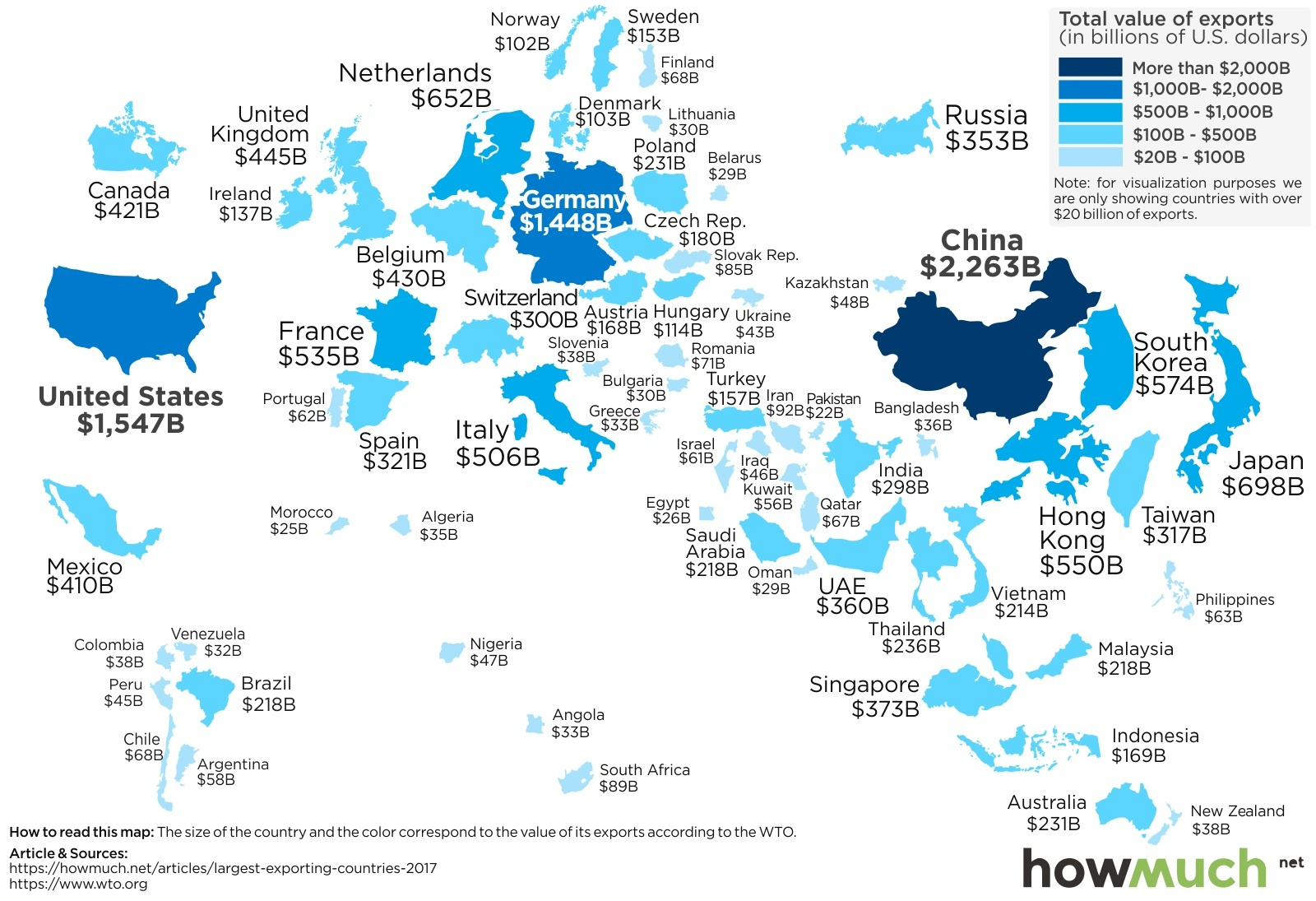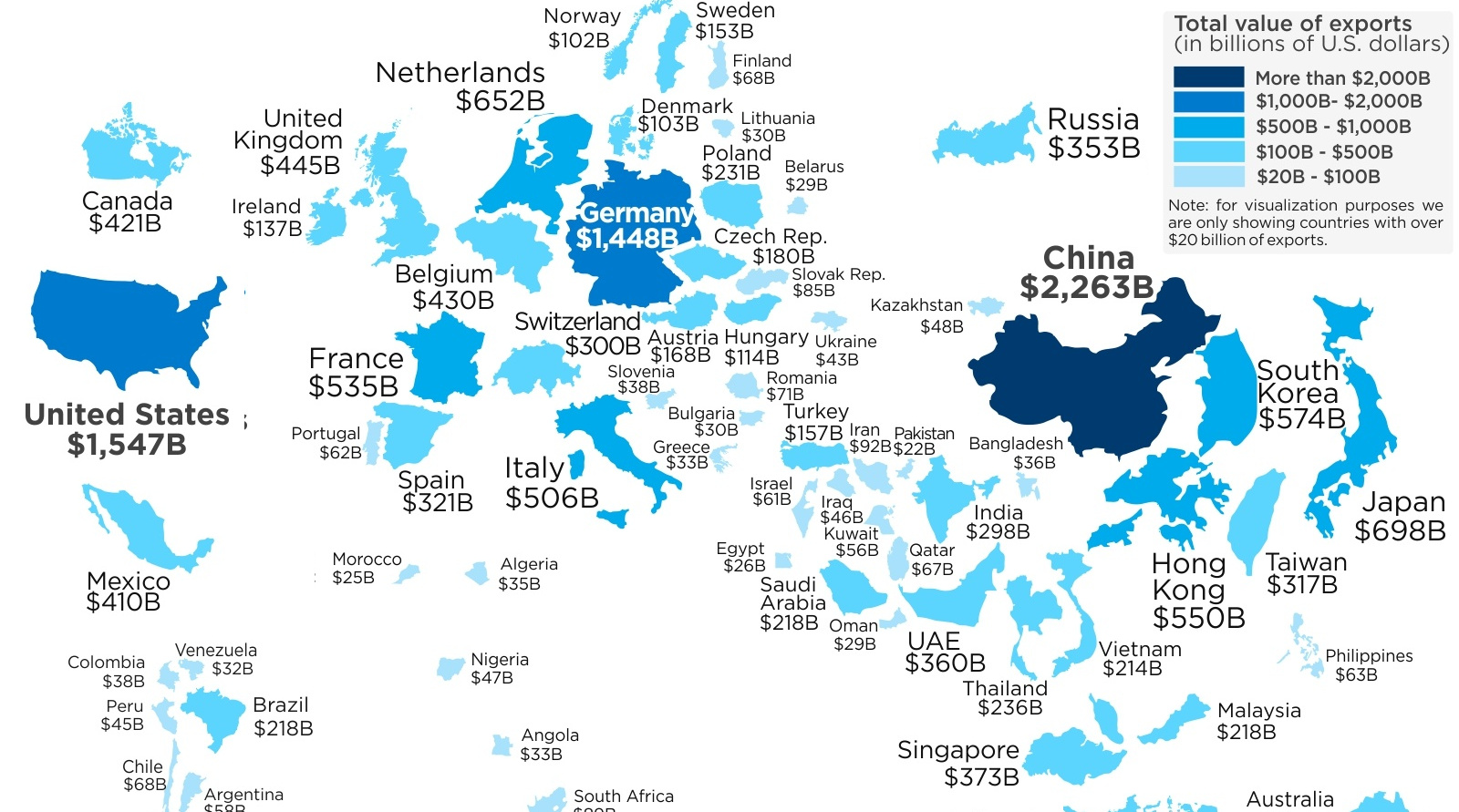Markets
Visualizing the World’s Biggest Exporters in 2017

Visualizing the World’s Biggest Exporters in 2017
For the first time in decades, trade barriers appear to be increasing around the world.
Brexit negotiations have helped to create an environment of uncertainty, while the introduction of American tariffs on imports of steel and aluminum – along with the resulting retaliatory measures – have created more tangible barriers to international trade.
Now, there is now even rhetoric coming from D.C. about adding tariffs to $200 billion of goods coming from China, and NAFTA renegotiations have long been on President Trump’s agenda.
The G7 meeting in Canada also gave recent indications on the state of the existing trade atmosphere. For the first time in recent memory, the meeting of Western leaders was tense, resulting in name-calling and accusations, giving the impression that the worst could be yet to come.
Who are the World’s Biggest Exporters?
As the environment around trade shifts, it’s worth noting the countries that have the biggest stakes in international trade to start with.
Both imports and exports matter, but today’s map from HowMuch.net focuses exclusively on the world’s biggest exporters. Each country is re-sized based on the latest export data from the World Trade Organization for 2017, and countries with fewer than $20 billion in exports are excluded altogether.
Here are the 10 countries with the most exports in 2017:
| Rank | Country | Exports (2017) |
|---|---|---|
| #1 | China | $2,263B |
| #2 | United States | $1,547B |
| #3 | Germany | $1,448B |
| #4 | Japan | $698B |
| #5 | Netherlands | $652B |
| #6 | South Korea | $574B |
| #7 | Hong Kong | $550B |
| #8 | France | $535B |
| #9 | Italy | $506B |
| #10 | United Kingdom | $445B |
China leads the way with $2.26 trillion in exports per year, but the country also has a sizable population of nearly 1.4 billion.
Germany, which is a massive exporter of automobiles, sends a whopping $1.45 trillion of goods abroad every year despite only having 83 million people. That’s an astounding $18,000 per person in exports.
The United States is the world’s second largest exporter in terms of absolute value. However, if you compare it on a per capita basis to a nation like Germany, it’s clear that the U.S. relies less on exports overall. The country exported $1.55 trillion in goods in 2017, about $4,800 per person.
Maps
Mapped: The 10 U.S. States With the Lowest Real GDP Growth
In this graphic, we show where real GDP lagged the most across America in 2023 as high interest rates weighed on state economies.

The Top 10 U.S. States, by Lowest Real GDP Growth
This was originally posted on our Voronoi app. Download the app for free on iOS or Android and discover incredible data-driven charts from a variety of trusted sources.
While the U.S. economy defied expectations in 2023, posting 2.5% in real GDP growth, several states lagged behind.
Last year, oil-producing states led the pack in terms of real GDP growth across America, while the lowest growth was seen in states that were more sensitive to the impact of high interest rates, particularly due to slowdowns in the manufacturing and finance sectors.
This graphic shows the 10 states with the least robust real GDP growth in 2023, based on data from the Bureau of Economic Analysis.
Weakest State Economies in 2023
Below, we show the states with the slowest economic activity in inflation-adjusted terms, using chained 2017 dollars:
| Rank | State | Real GDP Growth 2023 YoY | Real GDP 2023 |
|---|---|---|---|
| 1 | Delaware | -1.2% | $74B |
| 2 | Wisconsin | +0.2% | $337B |
| 3 | New York | +0.7% | $1.8T |
| 4 | Missississippi | +0.7% | $115B |
| 5 | Georgia | +0.8% | $661B |
| 6 | Minnesota | +1.2% | $384B |
| 7 | New Hampshire | +1.2% | $91B |
| 8 | Ohio | +1.2% | $698B |
| 9 | Iowa | +1.3% | $200B |
| 10 | Illinois | +1.3% | $876B |
| U.S. | +2.5% | $22.4T |
Delaware witnessed the slowest growth in the country, with real GDP growth of -1.2% over the year as a sluggish finance and insurance sector dampened the state’s economy.
Like Delaware, the Midwestern state of Wisconsin also experienced declines across the finance and insurance sector, in addition to steep drops in the agriculture and manufacturing industries.
America’s third-biggest economy, New York, grew just 0.7% in 2023, falling far below the U.S. average. High interest rates took a toll on key sectors, with notable slowdowns in the construction and manufacturing sectors. In addition, falling home prices and a weaker job market contributed to slower economic growth.
Meanwhile, Georgia experienced the fifth-lowest real GDP growth rate. In March 2024, Rivian paused plans to build a $5 billion EV factory in Georgia, which was set to be one of the biggest economic development initiatives in the state in history.
These delays are likely to exacerbate setbacks for the state, however, both Kia and Hyundai have made significant investments in the EV industry, which could help boost Georgia’s manufacturing sector looking ahead.
-

 Personal Finance1 week ago
Personal Finance1 week agoVisualizing the Tax Burden of Every U.S. State
-

 Misc7 days ago
Misc7 days agoVisualized: Aircraft Carriers by Country
-

 Culture1 week ago
Culture1 week agoHow Popular Snack Brand Logos Have Changed
-

 Mining1 week ago
Mining1 week agoVisualizing Copper Production by Country in 2023
-

 Misc1 week ago
Misc1 week agoCharted: How Americans Feel About Federal Government Agencies
-

 Healthcare1 week ago
Healthcare1 week agoWhich Countries Have the Highest Infant Mortality Rates?
-

 Demographics1 week ago
Demographics1 week agoMapped: U.S. Immigrants by Region
-

 Maps1 week ago
Maps1 week agoMapped: Southeast Asia’s GDP Per Capita, by Country













